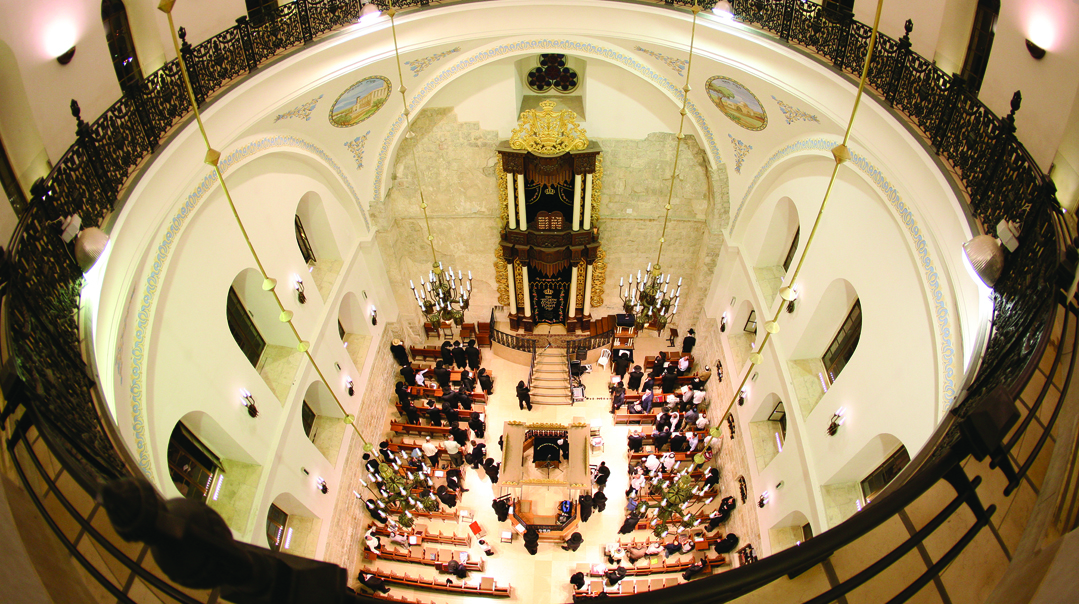Ten World-Famous Shuls


What is your shul like? Is it big? Is it small? Is it a basement with some folding chairs and tables or is it a great, big building with a high ceiling? Today we visit ten of the most amazing shuls in the world.
![]()
![]()

Belzer Shul, Yerushalayim
The biggest shul in the world is the Belzer Shul of Yerushalayim. It has 8,000 seats. On Rosh Hashanah and Yom Kippur, when many Belzer chassidim from around the world come to spend the Yamim Noraim with their rebbe, another 2,000 seats are added. There are over 70 sifrei Torah in the massive aron kodesh. The Belzer Rebbe wanted this huge shul to be built as a lasting memory of the Great Shul of Belz that his great-great-grandfather, Rav Shalom of Belz, built in 1843. That shul sat 5,000 people.
Altneu Shul, Prague, Czech Republic
The oldest shul in the world still in use is Prague’s Altneu Shul, built in 1270. There’s a legend that the Maharal of Prague hid the clay to make his golem in the attic of this shul.
Altneu is Yiddish, meaning “old-new,” because it was once a new shul, but when other shuls were built in Prague, they called it the “old, new shul.” Some say that the word altneu comes from the Hebrew “al tenai” meaning “on condition.” The legend goes that some of the stones used to build the shul were brought there from the Beis Hamikdash by malachim to be used on condition the stones are returned to Yerushalayim when Mashiach comes.
Touro Synagogue, Newport, Rhode Island
North America’s oldest shul is the Touro Synagogue in Newport, Rhode Island. It was founded in 1763 by Chazan Isaac Touro, a Jew from Holland. Holland was once owned by Spain and many Spanish and Portuguese Jews fled from to Holland, because Holland was a free country, while Spain and Portugal killed Jews who didn’t convert to Christianity. These Jews came to America and founded the Touro Synagogue. The floor of the shul has a trapdoor leading to an underground tunnel — apparently its first congregants were traumatized by their experiences and weren’t taking any chances.… In 1790 George Washington wrote a letter to the shul members, which is still prized to this day. He also came to visit the shul — and he wasn’t the only president to visit; Jefferson, Truman, Eisenhower, and John F. Kennedy also paid the shul a visit.
Portuguese Synagogue, Amsterdam, Holland
Another famous shul is the Portuguese Synagogue of Amsterdam. This shul was built in 1675 by Sephardic Jews who fled Spain and Portugal. Its magnificent architecture shows how wealthy they were. Since then, the shul has undergone restorations but it still looks pretty much the same as when it was first built. When the Nazis invaded in 1941, they didn’t destroy the shul, which was very unusual. The shul’s floor has fine sand on it, so you can’t hear people’s footsteps and also so water or dirt doesn’t get on the floor. During service, 1,000 candles in two enormous brass chandeliers light the synagogue.
Abuhav Shul, Tzfas, Eretz Yisrael
One of the most beautiful and holy shuls in the world is the Abuhav shul of Tzfas. It was built in the 1490s by the students of the Spanish tzaddik, Rav Yitzchak Abuhav. Some say the shul was built in Spain and miraculously flown to Tzfas using kabbalistic kavanos. Colorful cushioned seats are positioned all the way around the walls, and on the ceiling there are huge ornate crystal chandeliers and wonderful paintings of all the musical instruments that the Leviim would play in the Beis Hamikdash. The shul still has the sefer Torah written by Rav Yitzchak Abuhav, read from three times a year: Rosh Hashanah, Yom Kippur, and Shavuos. It might be the oldest sefer Torah still in use.
Chabad Shul, 770 Eastern Parkway, Brooklyn, NY
One of the most used shuls in the world is Chabad-Lubavitch headquarters in the Crown Heights section of Brooklyn, known simply as 770. It’s been expanded many times to hold the many chassidim who came to hear sichos from the Lubavitcher Rebbe. World leaders and famous people lined up next to regular Jews, to meet the Rebbe, who gave a dollar to each visitor, to put in tzedakah. Inside 770 are yeshivos and minyanim that learn and daven day and night.
Shomrei Shabbos, Boro Park, Brooklyn, NY
The shul that might have the most minyanim is Shomrei Shabbos in Boro Park. Minyanim start every 15 minutes, 24 hours a day. Not only is it a place to daven, but it’s stocked with food and drinks for anyone in need. One often sees poor people go there to get some food or sleep on a bench.
Churva Shul, Yerushalayim
The Churva Shul was built in the early 1700s, on what’s said to be the same spot as a shul Rabi Yehuda Hanasi davened in, 1,800 years ago. It was once so beautiful that it was described as “The Glory of the Old City of Yerushalayim.” It was destroyed twice — in 1721 and 1948 — and rebuilt twice. Jews come from all over to daven there. Rav Yosef Shalom Elyashiv ztz”l had his bar mitzvah there.
Paradesi Shul, Kochi, India
The Paradesi Shul is one of the world’s oldest shuls still in use. It was built in 1567 by Sephardic Jews who moved to India to join the Jewish community in Cochin. These Sephardic Jews were called “Paradesi” by the Cochin Jews, which means stranger, because these Jews were unknown to the Jews of India. If you want to daven in the Paradesi Shul, you must enter barefoot.
The Cochin are the descendants of Jews who went to India during the time of the First Beis Hamikdash, close to 3,000 years ago.
The Beis Hamikdash, Yerushalayim
The most famous shul ever built was the Beis Hamikdash, first built by Dovid Hamelech and his son Shlomo Hamelech, almost 3,000 years ago. Jews saw miracles there on a daily basis and they became close to Hashem. The Beis Hamikdash was open to all, even non-Jews, who were allowed to bring certain korbanos. But because we did aveiros, it was destroyed after 410 years. It was rebuilt and stood for 420 more years (the Second Beis Hamikdash) but then destroyed again. We daven every day that it be rebuilt once more, speedily in our days.
The Kedushah of a Shul
When we daven in a shul, we have to be very careful to act properly. A shul today is like a small version of the Beis Hamikdash. Hashem’s Presence is in the shul. Imagine you would meet a president or king. How would you act? Would you run around while he was there? Would you joke around with your friends in front of him? Would you use a cell phone to call or text your friends in front of him? Of course not. You’d stand respectfully and tell him what you need. If we’d act respectfully in front of a president or human king, how much more so should we act respectfully in Hashem’s house.
Once, President Bush was giving a press conference to a group of reporters, when someone’s cell phone rang loudly. President Bush stopped and said angrily, “Surely that phone call must be very important!” The reporter whose cell phone rang was very embarrassed for not respecting his meeting with President Bush.
We must be very careful to have at least that much respect for Hashem.
Eliyahu Hanavi’s Visit
When the Belzer Rebbe, Rav Shalom Rokeach, was building the huge shul of Belz in 1843, he’d join the bricklayers in the hard labor. His brother Reb Leibush was upset with him. “Surely you know it’s improper for someone like you to do such work. You’re a rav!”
Rav Shalom answered him with the following story: “When I was younger, two friends and I tried to stay awake learning for 1,000 nights in a row, because we were taught that if we did that, we’d see Eliyahu Hanavi. One friend stopped after a few hundred nights, and the other after 800. I kept on going until the thousandth night. That night a tremendous storm broke out, with howling winds that blew out all of the candles and broke all the windows in the shul. I went to the aron kodesh and davened to Hashem to help me get through this night. The storm passed and all was quiet, when an old man appeared and started to teach me Torah. The last law he taught me was about the laws of a shul.” The Rebbe paused, then said, “If I had the strength, I’d build the entire shul myself.”
When the Nazis entered Belz in 1939, they tried to destroy the shul. But no matter what they tried, bombs or dynamite, they couldn’t destroy Rav Shalom of Belz’s shul. They forced the Jews of Belz to take apart the shul brick by brick.
(Originally featured in Jr, Issue 577)
Oops! We could not locate your form.


